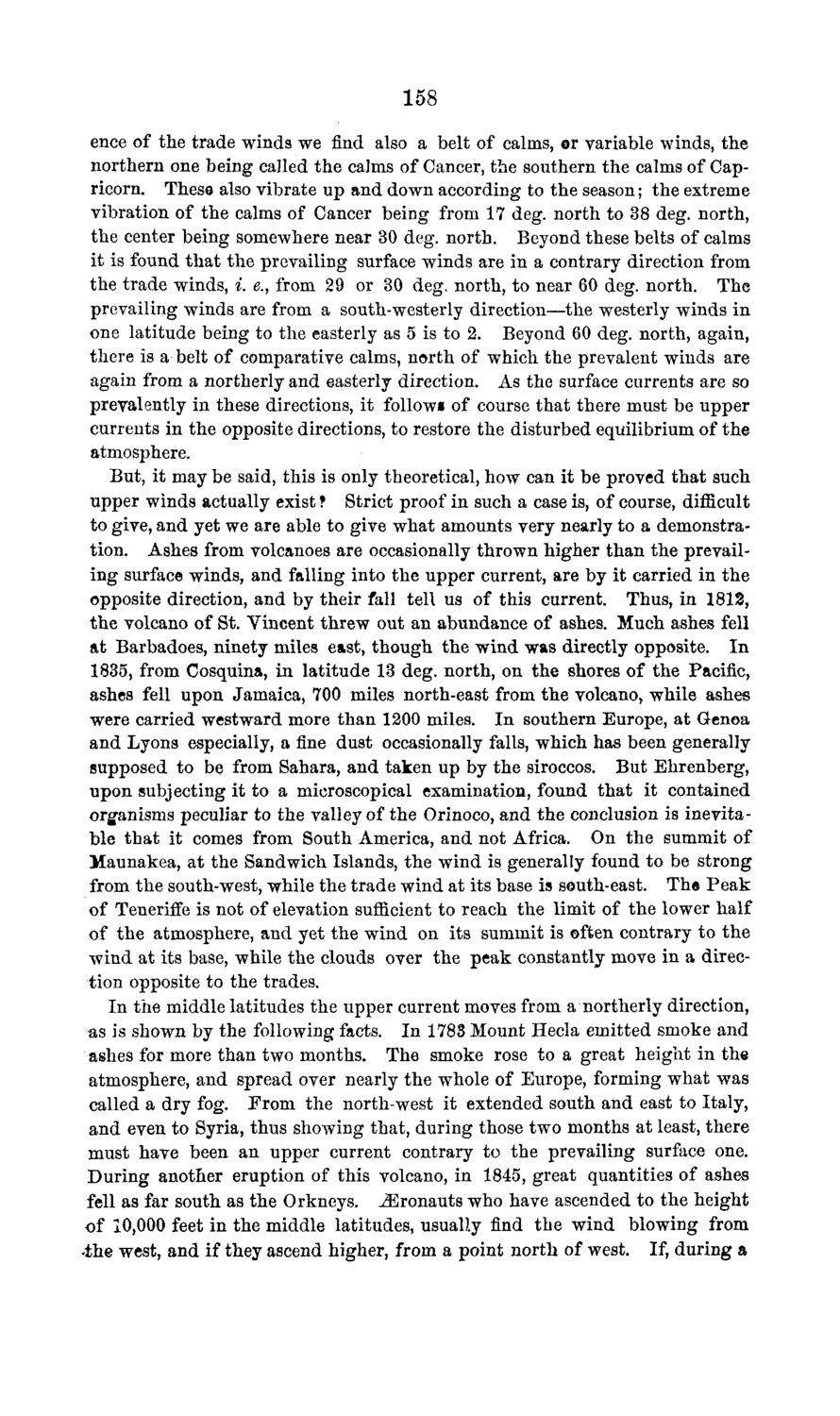| |
| |
Caption: Board of Trustees Minutes - 1869
This is a reduced-resolution page image for fast online browsing.

EXTRACTED TEXT FROM PAGE:
158 ence of the trade winds we find also a belt of calms, or variable winds, the northern one being called the calms of Cancer, the southern the calms of Capricorn. These also vibrate up and down according to the season; the extreme vibration of the calms of Cancer being from 17 deg. north to 38 deg. north, the center being somewhere near 30 deg. north. Beyond these belts of calms it is found that the prevailing surface winds are in a contrary direction from the trade winds, i. e., from 29 or 30 deg. north, to near 60 deg. north. The prevailing winds are from a south-westerly direction—the westerly winds in one latitude being to the easterly as 5 is to 2. Beyond 60 deg. north, again, there is a belt of comparative calms, north of which the prevalent winds are again from a northerly and easterly direction. As the surface currents are so prevalently in these directions, it followi of course that there must be upper currents in the opposite directions, to restore the disturbed equilibrium of the atmosphere. But, it may be said, this is only theoretical, how can it be proved that such upper winds actually exist ? Strict proof in such a case is, of course, difficult to give, and yet we are able to give what amounts very nearly to a demonstration. Ashes from volcanoes are occasionally thrown higher than the prevailing surface winds, and falling into the upper current, are by it carried in the opposite direction, and by their fall tell us of this current. Thus, in 1812, the volcano of St. Vincent threw out an abundance of ashes. Much ashes fell at Barbadoes, ninety miles east, though the wind was directly opposite. In 1835, from Cosquina, in latitude 13 deg. north, on the shores of the Pacific, ashes fell upon Jamaica, 700 miles north-east from the volcano, while ashes were carried westward more than 1200 miles. In southern Europe, at Genoa and Lyons especially, a fine dust occasionally falls, which has been generally supposed to be from Sahara, and taken up by the siroccos. But Ehrenberg, upon subjecting it to a microscopical examination, found that it contained organisms peculiar to the valley of the Orinoco, and the conclusion is inevitable that it comes from South America, and not Africa. On the summit of Maunakea, at the Sandwich Islands, the wind is generally found to be strong from the south-west, while the trade wind at its base is south-east. The Peak of Teneriffe is not of elevation sufficient to reach the limit of the lower half of the atmosphere, and yet the wind on its summit is often contrary to the wind at its base, while the clouds over the peak constantly move in a direction opposite to the trades. In the middle latitudes the upper current moves from a northerly direction, as is shown by the following facts. In 1788 Mount Hecla emitted smoke and ashes for more than two months. The smoke rose to a great height in the atmosphere, and spread over nearly the whole of Europe, forming what was called a dry fog. From the north-west it extended south and east to Italy, and even to Syria, thus showing that, during those two months at least, there must have been an upper current contrary to the prevailing surface one. During another eruption of this volcano, in 1845, great quantities of ashes fell as far south as the Orkneys. iEronauts who have ascended to the height of 10,000 feet in the middle latitudes, usually find the wind blowing from .the west, and if they ascend higher, from a point north of west. If, during a
| |